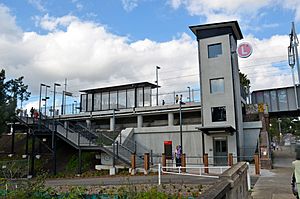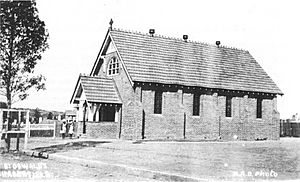Haberfield, New South Wales facts for kids
Quick facts for kids HaberfieldSydney, New South Wales |
|||||||||||||||
|---|---|---|---|---|---|---|---|---|---|---|---|---|---|---|---|

Aerial photograph of Haberfield
|
|||||||||||||||
| Postcode(s) | 2045 | ||||||||||||||
| Elevation | 21 m (69 ft) | ||||||||||||||
| Location | 6.4 km (4 mi) west of Sydney CBD | ||||||||||||||
| LGA(s) | Inner West Council | ||||||||||||||
| State electorate(s) | Summer Hill | ||||||||||||||
| Federal Division(s) | Grayndler | ||||||||||||||
|
|||||||||||||||
Haberfield is a lovely suburb in the Inner West part of Sydney, New South Wales, Australia. It's about 6.5 kilometres west of the Sydney city centre. This area is looked after by the Inner West Council, which is a type of local government.
Haberfield is located south of Iron Cove, which is a bay connected to Sydney Harbour. It has natural borders like the Hawthorne Canal to the east and the Iron Cove Creek canal to the northwest. Parramatta Road forms its border to the southwest. Ramsay Street is the main road here. The land pointing towards Iron Cove is called Dobroyd Point, and it has a long history in Sydney.
Haberfield was known as "the garden suburb" in the early 1900s. It still has beautiful parks, streets lined with trees, and amazing houses from the Federation era with perfect gardens. The whole suburb is protected for its history. It's also famous for its strong Italian culture.
Contents
History of Haberfield
Haberfield got its name from Richard Stanton, an early landowner. He named it after Lord Haberfield, who was a financial helper for his wife's family.
Early Aboriginal History
The land where Haberfield now stands was once home to Aboriginal people. They were part of the Darug tribe, specifically the Wangals or Cadigals, who belonged to the Eora nation. The Hawthorne Canal, which you can still see today, is thought to have been the border between these two groups.
There isn't much proof of Aboriginal settlements right in Haberfield. However, this area was one of the last parts of inner-west Sydney to be built on. Because of this, in the late 1800s, it became a place where local kooris (Aboriginal people) lived again.
European Settlement and Development
The first land grant in this area was given to Nicholas Bayly, a soldier, in 1803. But he sold it just two years later to Simeon Lord. Lord named the land Dobroyde Estate. In 1825, Lord gave the land to his daughter, Sarah Ann, and her new husband, David Ramsay, as a wedding gift. The Ramsay family owned the land until the end of the 1800s.
The Ramsays grew fruit on their land and built several grand houses for their family members. Two of these houses were Yasmar (which is Ramsay spelled backwards) and St David's Presbyterian church. They also created four of the streets you see in Haberfield today: Ramsay Street, Dalhousie Street (named after their family home in Scotland), Boomerang Street, and Waratah Street.
In 1901, a landowner named Richard Stanton bought about 50 acres (20 hectares) from two of the Ramsay children. He then divided this land into smaller blocks to create a "garden suburb." At that time, Sydney had faced outbreaks of the bubonic plague in crowded city areas. The idea of a garden suburb was a way to encourage fresh air and healthier living. Stanton even said his new development would be "slumless, laneless and publess."
The houses were designed by the architectural firm Spencer, Stansfield and Wormald. Stanton named the suburb 'Haberfield' after his family's English relatives. Because the development started in 1901 and many early streets were named after important federal politicians, Haberfield is also known as 'The Federation Suburb'.
Protecting Haberfield's Heritage
Most houses in Haberfield are protected by a 'heritage order'. This is why so many original Victorian and Federation style houses still exist here. If people want to renovate or add to their homes, they must follow strict rules. These rules make sure the changes match the original style of the era.
For example, you usually can't add a second floor unless it's within the existing roof space. You also can't tear down any protected houses. Properties must have a good balance of 'hard surfaces' (like driveways) and 'soft surfaces' (like gardens). House exteriors must be painted in traditional Federation colours. Also, roofs must be made of terracotta or slate tiles.
One famous landmark is Yasmar, located at 185 Parramatta Road. This building was built around 1870 from dressed stone. It has a verandah with iron columns, French windows, and beautiful cedar wood inside. It's surrounded by a lush garden. Yasmar was later part of a juvenile centre and is listed as a heritage site.
Haberfield has a special group called a heritage association. This group helps residents take care of their historic properties.
Haberfield in the 21st Century
In 2011, McDonald's wanted to build a drive-thru restaurant on Parramatta Road in Haberfield. Many local residents strongly disagreed. They wanted to protect the suburb's "cultural and architectural heritage." The local council rejected the plan in 2009. However, McDonald's took the case to the Land and Environment Court of New South Wales. The court allowed the appeal in 2011, but with some changes to the building design. After McDonald's opened, there were some complaints about smells coming from the site in 2012 and 2013.
Important Heritage Sites
Haberfield has several places that are listed for their historical importance. These include:
- 51- 53 Dalhousie Street: St David's Uniting Church
- 16 Deakin Avenue: Derrylyn
- 185 Parramatta Road: Yasmar
- 5 Rogers Avenue: The Bunyas
- 11 St Davids Road: St. David's Road Depot
Shopping and Food
Haberfield has a strong Italian feel, especially in the shops along Ramsay Street, near Dalhousie Street. Here, you can find many Italian businesses. There's a shop that makes fresh pasta by hand, a traditional Italian bakery, and pastry shops with both old and new Italian sweets. You'll also find Italian delicatessens and butchers. Plus, there are many Italian cafes, coffee shops, and restaurants. The main supermarket in Haberfield is IGA Lamonica, which also has a great deli inside. Many of the shops in Haberfield have won awards for their excellent quality.
Schools in Haberfield
Haberfield has three primary schools, but no high schools. Two of the schools are public schools run by the state: Haberfield Public School on the corner of Bland Street and Denman Avenue, and Dobroyd Point Public School on Waratah Street. The third school is St Joan of Arc Catholic School on Dalhousie Street, across from St Joan of Arc Church.
Getting Around Haberfield

The Inner West Light Rail runs along the eastern edge of Haberfield, near Leichhardt. Because of this, the three light rail stops that serve Haberfield are not right in the middle of the suburb. Hawthorne (near Barton Avenue) and Marion (near Marion Street) are the main stops for Haberfield residents. Taverners Hill (near Parramatta Road) is in the southeast corner of the suburb. The light rail connects directly to Pyrmont and Darling Harbour. You can also change trains at Lewisham railway station for the Inner West & Leppington Line or at Dulwich Hill railway station for the Bankstown Line.
Several bus routes also serve Haberfield. Route 461 comes from the city along Parramatta Road. Route 406 travels from Five Dock or Hurlstone Park through Dalhousie Street. Routes 438 and 439 come from the city or Abbotsford/Mortlake via Ramsay Street.
Summer Hill railway station, on the T2 Inner West & Leppington Line, is close to Haberfield's southern border. A new station, Five Dock railway station, on the Sydney Metro West line, will serve the nearby suburb of Five Dock.
In July 2019, the Westconnex M4 East tunnel opened. This tunnel means you can drive for 51 kilometres without traffic lights, from Glenbrook (near Penrith) all the way to Haberfield.
People of Haberfield
Demographics of Residents
In the 2021 census, there were 6,480 people living in Haberfield. The population was a bit older than average, with a median age of 46. About 22.2% of residents were aged 65 or older. Most people (69.8%) were born in Australia. The next most common birthplaces were Italy (10.6%) and England (3.0%).
When it came to religion, most people identified as Catholic (44.1%) or had no religion (32.5%). About 70.7% of people spoke only English at home. Other languages spoken at home included Italian (16.1%) and Greek (2.0%).
Famous People from Haberfield
Some well-known people were either born in or lived in Haberfield:
- Norman Allan (1901–1977), who was the NSW police commissioner from 1962 to 1972.
- Bronwyn Oliver (1959–2006), a famous sculptor.
- Richard Glover, a radio presenter.
- Ellen Fanning, a journalist (who moved away around 2016).
- Odette, a musician (who attended Haberfield Public School).
Images for kids
Churches in Haberfield
Haberfield has four historic churches located on Dalhousie Street. These include St Oswalds Anglican Church, Saint Joan of Arc Catholic Church, St Davids Uniting Church, and Haberfield Baptist Church.
Houses of Haberfield
Around 1500 houses were built in Haberfield and nearby areas. They were designed by architects J Spencer Stansfeld and D Wormald. These homes were built in the Federation or Bungalow styles.
Haberfield was designed with the idea of a "Garden Suburb." This meant houses had special gardens with unique plants, fences, gates, and curving tiled paths. Homes in Haberfield were usually 'detached' double-brick houses. They sat on their own block of land, typically measuring 15 metres by 45 metres. No two houses were exactly alike, but they shared many common features. Their roofs were made of slate or Marseilles tile. All houses had front verandahs. You can often see decorative features like leadlight windows showing Australian plants and animals, Art Nouveau wood details, and special brickwork called tuckpointing.
Here are some houses listed under the NSW Heritage Act:
- Bunyas, 5 Rogers Avenue, Haberfield
- Derrylyn, 16 Deakin Avenue, Haberfield
- Yasmar, 185 Parramatta Road, Haberfield
Parks and Green Spaces
Haberfield has several lovely parks and green areas for everyone to enjoy. These include Algie Park, Robson Park, Reg Cody Reserve, Hawthorne Canal, and Wadim 'Bill' Jegorow Reserve.
-
View of Iron Cove Creek with Wadim (Bill) Jegorow Reserve on the right



















